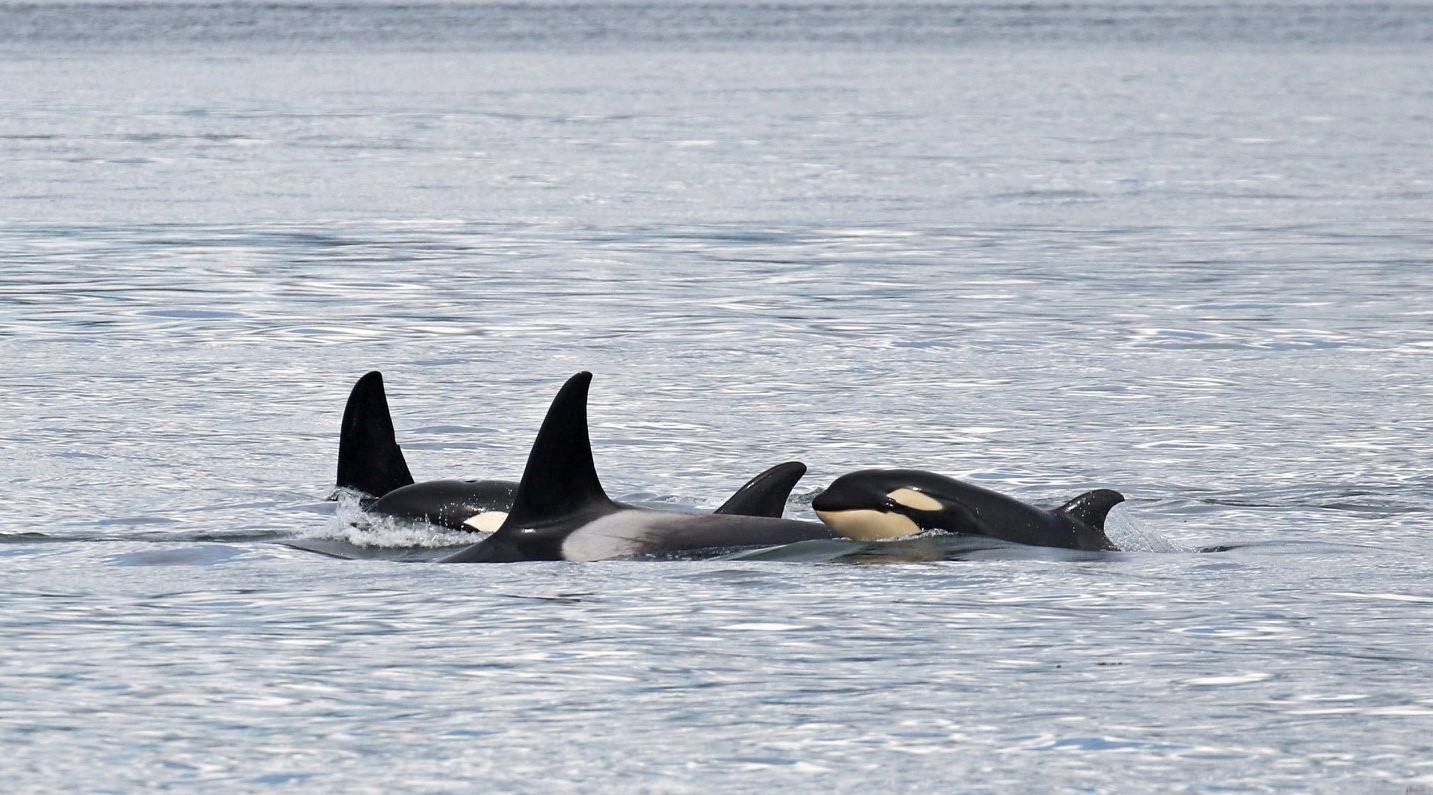Everybody loves baby animals and baby killer whales are no exception. Baby whales are called calves and they usually look like miniature versions of their adult forms. When killer whale calves are born, they are about 6 feet in length and 450 lbs. in weight. While not exactly itty-bitty, they are very small compared to their 6-tonne mamas! Besides their (relatively) small size, killer whale babies are distinguished by their slightly orange colouration and their stubby little rostra (‘snouts’). They also surface differently from adults, having not quite mastered the process of gliding to the surface. Calves tend to come up face-first and ‘hop’, making them look like they’re skipping along next to their mom’s sedate and graceful movements. All of these quirks make killer whale calves a delight to watch. They are even more special when seen around Victoria, because our resident killer whale population is critically endangered and every calf born is a potential boon to their future survival.
Last year, our Southern Resident Killer Whale population produced an unusually large number of calves. A total of eight calves were first seen between December 2014 and December 2015, earning this period the nickname of the ‘Baby Boom’. In a population that was hovering at 78 individuals, the addition of 8 little ones is a difference of almost 10 percent. This is a huge relief to the whale watching and research community that study our Southern Residents – at the beginning of 2014, their population size was the lowest it had been in 30 years, and none of the calves born in the past two years had survived to their first year. The mortality rate for killer whale calves in their first 12 months of life is very high: around 50%. So far, all eight of our little Baby Boomers are still alive and looking healthy, and some have even passed the 12-month danger zone. They are beating the odds, but their continued success will be determined by the care that is given to them by all the members of their pods, and especially their mothers.
Killer whale moms have a tough job and are incredibly invested in their young. They have a very long gestation period: anywhere from 15-18 months! When the calf is born, it is able to swim right away, but unable to fend for itself or hunt for solid food. As mammals, mother whales feed their young with milk that they draw from their own rich fat reserves. Killer whale calves nurse every 15 to 20 minutes, which makes it imperative that mom gets enough nutritious food to eat while she is nursing. The calf will start to be weaned off mother’s milk and onto solid food after a year and a half, but may continue to nurse to supplement its diet for up to four years. Because a mother whale can’t breed again until she finishes lactating, the inter-birth interval for a killer whale is about five years.
Let’s do some quick math, then. Female killer whales become reproductively mature at around 10 years old, and stop reproducing at around 42 years old. So, at one baby every five years, the total possible reproductive output for a female killer whale is eight calves in a lifetime (if all goes well). If only half of them survive, this means four successful calves per female. The Southern Resident population currently has 29 breeding-age females, eight of which will have their hands (or flippers) full for the next four years, which leaves 22 potential new moms. This is an optimistic number, but what about breeding age males?
There are 21 males over ten years old in our population; however, males don’t often successfully father offspring until their 20’s. Recent studies also suggest that Southern Residents are disproportionately fathered by only a few of the oldest males in the population. If our killer whale girls are looking for an older man, their options are limited, especially since only a small number of our males make it to their 30’s. No paternity testing has been done on the Baby Boomers yet, but I for one would be interested to know who the dads are.
Despite the recent Baby Boom, the Southern Residents are far from out of the woods. While the birth rate has increased, the death rate for older members of the population has been very high in recent years: up to eight animals per year have been discovered missing or deceased in the last ten years. So while this Baby Boom is a good sign, the Southern Residents need a few more years like this to increase their population faster than their members are dying. Already in 2016, L95 (Nigel), a 20-year-old male, was found deceased only a few days after the body of a young calf, only a few weeks old, was discovered off Sooke. These are saddening setbacks, but we’re still hopeful that this summer will yield even more bouncing little additions to the Southern Residents. A lot of hope rests on the tiny orange saddles of our youngest whales, who we hope will continue to be happy and healthy as they grow into (re)productive members of the community.
Kat Nikolich, MSc
Onboard Naturalist/Biologist for SpringTide Whale Watching & Eco Tours

